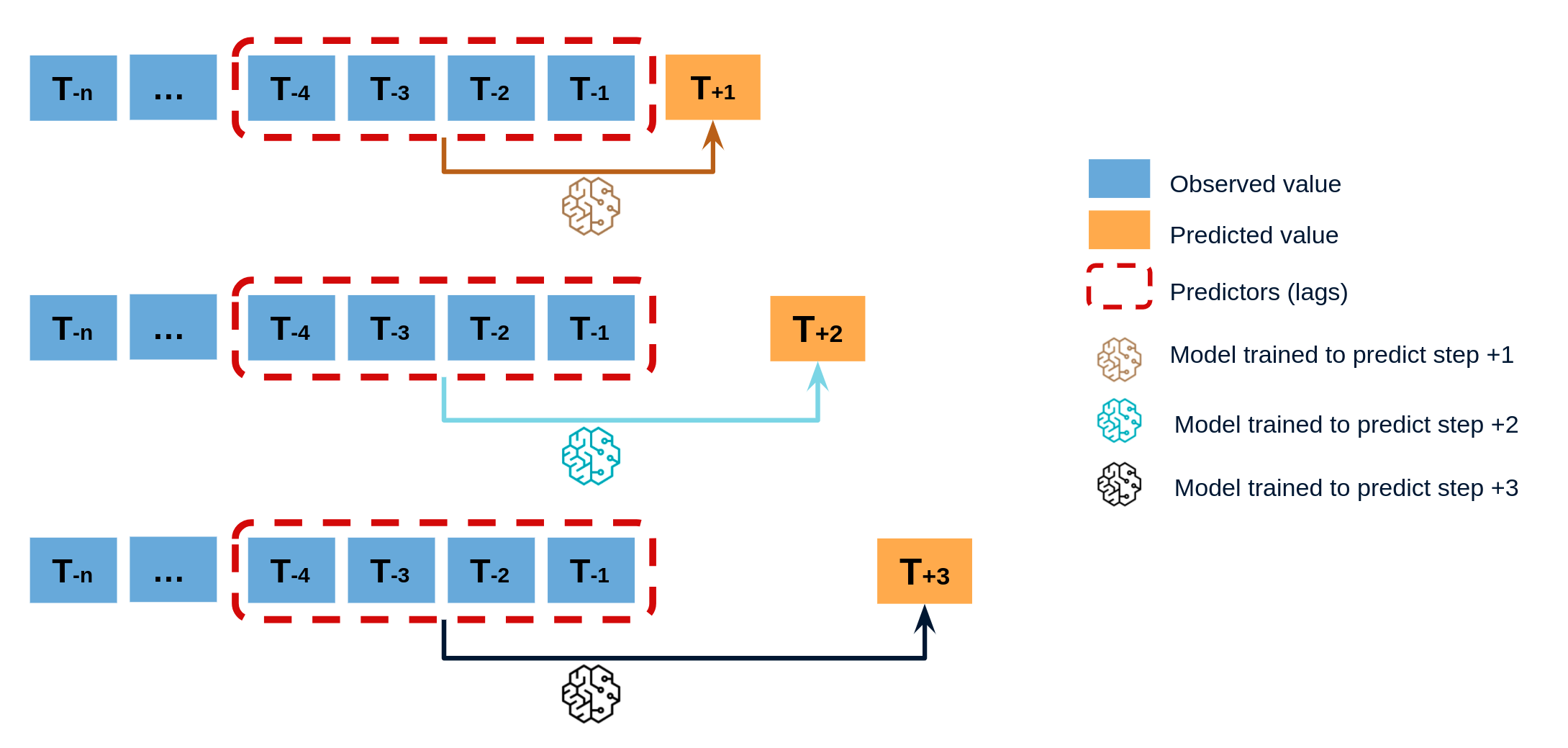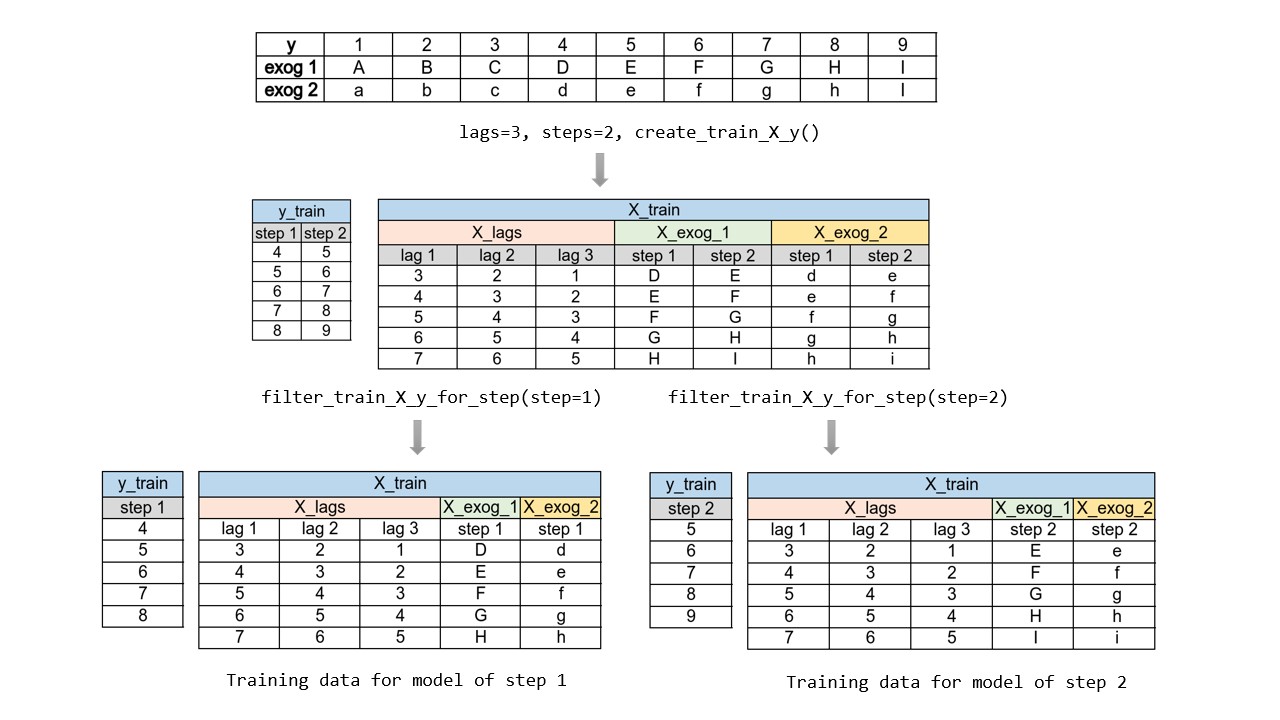Direct multi-step forecaster¶
This strategy, commonly known as direct multistep forecasting, is computationally more expensive than the recursive since it requires training several models. However, in some scenarios, it achieves better results. This type of model can be obtained with the ForecasterDirect class and can also include one or multiple exogenous variables.
Direct multi-step forecasting is a time series forecasting strategy in which a separate model is trained to predict each step in the forecast horizon. This is in contrast to recursive multi-step forecasting, where a single model is used to make predictions for all future time steps by recursively using its own output as input.
Direct multi-step forecasting can be more computationally expensive than recursive forecasting since it requires training multiple models. However, it can often achieve better accuracy in certain scenarios, particularly when there are complex patterns and dependencies in the data that are difficult to capture with a single model.
This approach can be performed using the ForecasterDirect class, which can also incorporate one or multiple exogenous variables to improve the accuracy of the forecasts.

Diagram of direct multi-step forecasting.

Direct forecasting
To train a ForecasterDirect a different training matrix is created for each model.

Transformation of a time series into matrices to train a direct multi-step forecasting model.
Libraries and data¶
# Libraries
# ==============================================================================
import pandas as pd
import matplotlib.pyplot as plt
from sklearn.linear_model import Ridge
from sklearn.metrics import mean_squared_error
from skforecast.datasets import fetch_dataset
from skforecast.preprocessing import RollingFeatures
from skforecast.direct import ForecasterDirect
# Download data
# ==============================================================================
data = fetch_dataset(
name="h2o", raw=True, kwargs_read_csv={"names": ["y", "datetime"], "header": 0}
)
# Data preprocessing
# ==============================================================================
data['datetime'] = pd.to_datetime(data['datetime'], format='%Y-%m-%d')
data = data.set_index('datetime')
data = data.asfreq('MS')
data = data['y']
data = data.sort_index()
# Split train-test
# ==============================================================================
steps = 36
data_train = data[:-steps]
data_test = data[-steps:]
# Plot
# ==============================================================================
fig, ax = plt.subplots(figsize=(6, 3))
data_train.plot(ax=ax, label='train')
data_test.plot(ax=ax, label='test')
ax.legend();
h2o --- Monthly expenditure ($AUD) on corticosteroid drugs that the Australian health system had between 1991 and 2008. Hyndman R (2023). fpp3: Data for Forecasting: Principles and Practice(3rd Edition). http://pkg.robjhyndman.com/fpp3package/,https://github.com/robjhyndman /fpp3package, http://OTexts.com/fpp3. Shape of the dataset: (204, 2)
Create and train forecaster¶
✎ Note
ForecasterDirect includes the n_jobs parameter, allowing multi-process parallelization. This allows to train regressors for all steps simultaneously.
The benefits of parallelization depend on several factors, including the regressor used, the number of fits to be performed, and the volume of data involved. When the n_jobs parameter is set to 'auto', the level of parallelization is automatically selected based on heuristic rules that aim to choose the best option for each scenario.
For a more detailed look at parallelization, visit Parallelization in skforecast.
# Create and fit forecaster
# ==============================================================================
forecaster = ForecasterDirect(
regressor = Ridge(),
steps = 36,
lags = 15,
window_features = RollingFeatures(stats=['mean'], window_sizes=10),
transformer_y = None,
n_jobs = 'auto'
)
forecaster.fit(y=data_train)
forecaster
ForecasterDirect
General Information
- Regressor: Ridge
- Lags: [ 1 2 3 4 5 6 7 8 9 10 11 12 13 14 15]
- Window features: ['roll_mean_10']
- Window size: 15
- Maximum steps to predict: 36
- Exogenous included: False
- Weight function included: False
- Differentiation order: None
- Creation date: 2024-11-08 16:36:08
- Last fit date: 2024-11-08 16:36:08
- Skforecast version: 0.14.0
- Python version: 3.11.10
- Forecaster id: None
Exogenous Variables
-
None
Data Transformations
- Transformer for y: None
- Transformer for exog: None
Training Information
- Training range: [Timestamp('1991-07-01 00:00:00'), Timestamp('2005-06-01 00:00:00')]
- Training index type: DatetimeIndex
- Training index frequency: MS
Regressor Parameters
-
{'alpha': 1.0, 'copy_X': True, 'fit_intercept': True, 'max_iter': None, 'positive': False, 'random_state': None, 'solver': 'auto', 'tol': 0.0001}
Fit Kwargs
-
{}
Prediction¶
When predicting, the value of steps must be less than or equal to the value of steps defined when initializing the forecaster. Starts at 1.
If
intonly steps within the range of 1 to int are predicted.If
listofint. Only the steps contained in the list are predicted.If
Noneas many steps are predicted as were defined at initialization.
# Predict
# ==============================================================================
# Predict only a subset of steps
predictions = forecaster.predict(steps=[1, 5])
display(predictions)
2005-07-01 0.952188 2005-11-01 1.180630 Name: pred, dtype: float64
# Predict all steps defined in the initialization.
predictions = forecaster.predict()
display(predictions.head(3))
2005-07-01 0.952188 2005-08-01 1.004327 2005-09-01 1.115190 Freq: MS, Name: pred, dtype: float64
# Plot predictions
# ==============================================================================
fig, ax = plt.subplots(figsize=(6, 3))
data_train.plot(ax=ax, label='train')
data_test.plot(ax=ax, label='test')
predictions.plot(ax=ax, label='predictions')
ax.legend();
# Prediction error
# ==============================================================================
predictions = forecaster.predict(steps=36)
error_mse = mean_squared_error(
y_true = data_test,
y_pred = predictions
)
print(f"Test error (mse): {error_mse}")
Test error (mse): 0.008447518677148016
Feature importances¶
Since ForecasterDirect fits one model per step, it is necessary to specify from which model retrieves its feature importances.
forecaster.get_feature_importances(step=1)
| feature | importance | |
|---|---|---|
| 11 | lag_12 | 0.551517 |
| 10 | lag_11 | 0.153757 |
| 0 | lag_1 | 0.138408 |
| 12 | lag_13 | 0.056914 |
| 1 | lag_2 | 0.050145 |
| 2 | lag_3 | 0.043166 |
| 9 | lag_10 | 0.019264 |
| 15 | roll_mean_10 | 0.016897 |
| 8 | lag_9 | 0.010420 |
| 7 | lag_8 | -0.014137 |
| 5 | lag_6 | -0.014835 |
| 4 | lag_5 | -0.019494 |
| 3 | lag_4 | -0.021308 |
| 6 | lag_7 | -0.022662 |
| 14 | lag_15 | -0.035939 |
| 13 | lag_14 | -0.071710 |
Training and prediction matrices¶
While the primary goal of building forecasting models is to predict future values, it is equally important to evaluate if the model is effectively learning from the training data. Analyzing predictions on the training data or exploring the prediction matrices is crucial for assessing model performance and understanding areas for optimization. This process can help identify issues like overfitting or underfitting, as well as provide deeper insights into the model’s decision-making process. Check the How to Extract Training and Prediction Matrices user guide for more information.